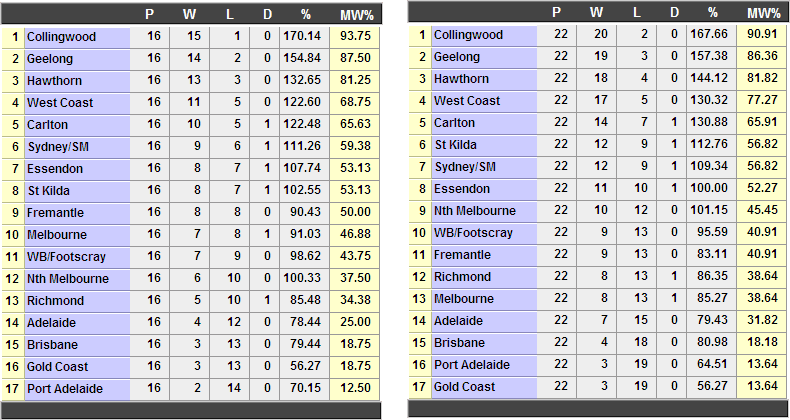While many are calling for a fair draw (e.g. by reducing the season to 17 rounds), it seems unlikely to happen due to the lower revenue the AFL would make. If it is possible to make the fixture fairer without increasing/decreasing the number of games and especially the number of blockbuster games, then it is something the AFL should definitely consider.
I believe I have a solution. I actually sent this to the AFL two years ago in anticipation of the 18-team competition - this year I think it would've worked well. Here is the system:
Each team plays each other once (rounds 1-17, or more if split rounds) - 8 home games each, and one `rivalry' game with shared gate revenue (or rotated each year. For non-Vic sides, this would obviously be WC v Freo, Adel v Port, etc.)
After round 17, the bottom six are excluded from premiership contention - they play each other in a round-robin over the last 5 rounds, with the highest ranked team awarded a priority pick (e.g. pick 7 - the draft order, however, it determined at round 17). This year, it is fair to say that six teams were out of contention at round 17. I would argue that supporters of these teams are more likely to attend these games, as their team has a greater chance of winning, and has something to play for.
The top 12 play five more games amongst themselves. These could be randomly allocated, or teams could be divided into two equal groups (e.g. 1,4,6,7,9,12 and 2,3,5,8,10,11). Points are carried over from round 17, with the final eight decided at round 22. This ensures that teams in contention play against other teams in contention (more blockbusters = better crowds and higher TV ratings).
Issues:
I believe I have a solution. I actually sent this to the AFL two years ago in anticipation of the 18-team competition - this year I think it would've worked well. Here is the system:
Each team plays each other once (rounds 1-17, or more if split rounds) - 8 home games each, and one `rivalry' game with shared gate revenue (or rotated each year. For non-Vic sides, this would obviously be WC v Freo, Adel v Port, etc.)
After round 17, the bottom six are excluded from premiership contention - they play each other in a round-robin over the last 5 rounds, with the highest ranked team awarded a priority pick (e.g. pick 7 - the draft order, however, it determined at round 17). This year, it is fair to say that six teams were out of contention at round 17. I would argue that supporters of these teams are more likely to attend these games, as their team has a greater chance of winning, and has something to play for.
The top 12 play five more games amongst themselves. These could be randomly allocated, or teams could be divided into two equal groups (e.g. 1,4,6,7,9,12 and 2,3,5,8,10,11). Points are carried over from round 17, with the final eight decided at round 22. This ensures that teams in contention play against other teams in contention (more blockbusters = better crowds and higher TV ratings).
Issues:
- home ground advantage over last 5 rounds. I think there are two options - one is to give the higher placed teams 3 home games and the lower placed 2 home games. Alternatively, the home team in each game is the away team from the previous meeting during rounds 1-17.
- no guarantee of two blockbuster games between big four VIC clubs and non-vic same state teams. Personally, I think the greater potential for blockbuster matches between top teams would be enough to counter this in terms of crowd numbers, TV ratings and revenue.





